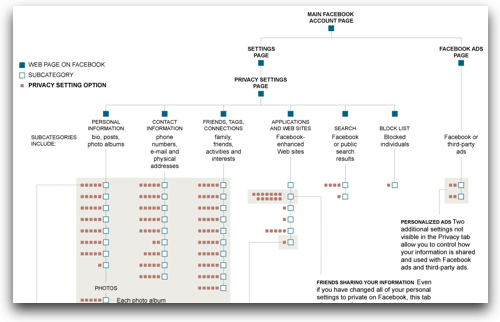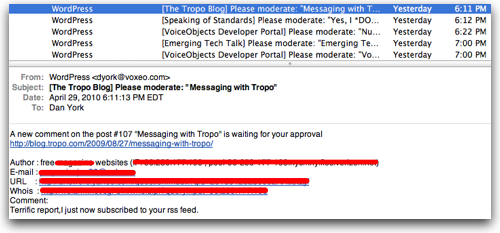 Much has been made in the social media part of the blogosphere about Ning’s recent decision to end their free services. In a post to their Ning Creators Forum titled “NING UPDATE: PHASING OUT FREE SERVICES“, the company posted an email from their CEO that said most importantly this:
Much has been made in the social media part of the blogosphere about Ning’s recent decision to end their free services. In a post to their Ning Creators Forum titled “NING UPDATE: PHASING OUT FREE SERVICES“, the company posted an email from their CEO that said most importantly this:
So, we are going to change our strategy to devote 100% of our resources to building the winning product to capture this big opportunity. We will phase out our free service. Existing free networks will have the opportunity to either convert to paying for premium services, or transition off of Ning.
The post outlined why they need to make the move – and disclosed the fact that they were laying off 69 people.
Some 700 comments later, they closed off comments to the post. The comments seemed to be a great number of very upset users of the free Ning service mixed in with a few folks defending Ning along with Ning employees who seemed to be trying to be genuinely helpful.
The comments across the blogosphere and Twittersphere raged quite strongly. ReadWriteWeb had a post listing alternatives, as did Mashable. TechCrunch reported on sites “welcoming Ning refugees”.
While the news sites may have reported it matter-of-factly, many other sites were full of passion. Many nonprofits and educational institutions wrote about how the were going to have to find some other home because they couldn’t afford fees. My friend Shel Holtz wrote a blistering post called “Ning reneges on its core promise, shatters customer trust“, which included this line:
But the word that keeps repeating in my mind is “betrayal.”
Strong stuff.
Betrayal? Or sound business decision? I understand the arguments on both sides.
IN THE BEGINNING
If you go back in time, Ning was launched with great fanfare in October 2005, a new startup by Marc Andresson of Netscape fame. Per the RWW article I just linked to, Ning’s FAQ (now gone) was:
“Our goal with Ning is to see what happens when you open things up and make it easy to create, share, and discover new social apps.”
I remember the launch… many of us tried it out. I think I even created a Ning network… although I can’t find any email or evidence that I really did. I know I joined a couple. The idea was cool… now anyone can create their own social network!
Over the years Ning raised over $120 million from investors and at one point was valued at over a half billion dollars. Mashable reported one year ago that there were over 1,000,000 networks created on Ning. Ning was one of the early supporters of OpenSocial and rolled out “Ning Apps” to Ning’s 1.5 million networks at that time. I know of many folks in the social media/marketing space who recommended Ning as a platform for people to build communities. I did to several groups. I was even considering using Ning as a platform for a community around my upcoming book like Steve Garfield did for his Get Seen book. (I opted for a blog and a Facebook page instead.)
IN THE END
It now seems rather clear that something was broken with the business model. $120 million dollars and 1.5 million networks later… they chopped 40% of the staff and dropped the free service that brought them so much attention and undoubtedly investment.
It sounds like from a company perspective they had little choice. As a recent Mashable post said (my emphasis added):
We’re not sure how pricing will change over the next few weeks, but what we do know is that the dotcom-era free-for-all of apps, services and content for end users is not-so-gradually coming to a halt. In the light of economic reality, nothing is free. Someone — be it an advertiser, an administrator, an investor or an entrepreneur — is footing the bill for every one and zero that’s electronically transmitted across this great Internet of ours. And at some point, most of those folks expect to see a return on their investment.
“And at some point, most of those folks expect to see a return on their investment.“… indeed. And $120 million of investment is a lot to seek a return on. I can understand that they didn’t have many great choices… and were undoubtedly running out of time.
TRUST AND BETRAYAL
On the other hand, I completely understand the anger, sadness, frustration and passion of all of those who built communities on Ning. Ning offered a great service … all you had to do was bear with seeing the ads that were displayed. In return you had powerful tools to build your own community.
You put your trust in Ning that they would provide this service for free – and now Ning has betrayed that trust.
I don’t envy all the nonprofits, schools, churches and other groups that used Ning as their community and built their communication infrastructure around that site. Sure, there are alternatives, but switching is a pain… you ideally want to move some or all of your content… and you have to bring all your users over with you… It is a lot of work.
It’s easy to say, as I’ve seen many commenters do, that “you get what you pay for“… and to chastise users of Ning’s free service to be so naive to think that it would be around for the long term. But why not? That was the promise made by the company. Build your community here and we’ll make it easy for you to maintain and grow – and so many networks did prosper there.
SPOFs AND “THE INTERNET WAY”
As Shel wrote in his post, I have this issue with “single points of failure” (SPOFs). I’ve written at great length about how Twitter and Facebook violate “The Internet Way” of distributed and decentralized services. I would add Ning to that list as well. It is a centralized service under the control of a single company… and a startup company at that.
The problem in relying on a single company/service/platform is that if you are locked in to that company/service/platform, you have a single point-of-failure.
They die… you die.
Compare the Ning situation to, say, garden-variety web hosting providers. You can get web hosting pretty much anywhere for an inexpensive amount of money. Upload your HTML files, point your domain there… ta da… your website is up and running.
Don’t like the web hosting provider? Or have too many service problems? Or have the web hosting provider fail as a business? No problem… sign up with another web hosting provider… upload your HTML files (you do have a backup, right?)… point your domain there… and ta da… you’re back in action. You have many, many, many choices for web hosting providers… it’s all distributed and decentralized.
CONTROL AND PORTABILITY
With a web hosting provider… or even an email provider… there is a fundamental feature:
YOU ARE IN CONTROL!
If you don’t like the provider, you can move. You aren’t locked in. Sure, it may be a pile of work… and moving your domain may be a hassle if you didn’t retain control of it… but it’s relatively straightforward to move. Even if you use PHP or other scripting languages, odds are that you can move your web site to another provider, because…
Web sites are portable as they are based on open standards.
Usually… unless, of course, the web hosting provider found some way to make your administration “simpler” and subsequently lock you in to their services.
When using Ning, though, you sacrifice that control and portability in the name of simplicity. It’s easy and simple (and free!) to set up a Ning community. It can be a lot harder to set up your own software on your own server – and it will probably cost you something. The same can be said of Facebook and using a Facebook Page or Group… or using any of the many other services out there that let you build communities.
A HARSH LESSON
Sadly, hundreds of thousands of actual users (perhaps millions) are learning about control and portability in a bitter and harsh lesson. They will soon learn about what pricing Ning will be offering… and they will have to make their choices. Pay some fee… move their community… or simply shut it down. I already know that one of the ones I am a member of will be moving. I expect many others will move as well.
I can only hope… and that is what it is – “hope”… that as Ning community administrators look at alternatives, they will ask those providers the tough questions, like:
- How do I know you will be around in a while?
- How can I trust you not to screw me like Ning just did?
- What is your business model?
- How easy is it for me to move my community OFF of your platform if I choose to do so?
And so on…
As for Ning, I wish them luck… I somehow think they’re going to need it.
UPDATE: John Cass has an excellent post tracking many good posts involved in the conversation about Ning’s changes.
If you found this post interesting or useful, please consider either subscribing to the RSS feed or following me on Twitter or subscribing to my email newsletter.

 Timing is everything.
Timing is everything.  Tech superstar Leo Laporte
Tech superstar Leo Laporte 



 As listeners to
As listeners to 